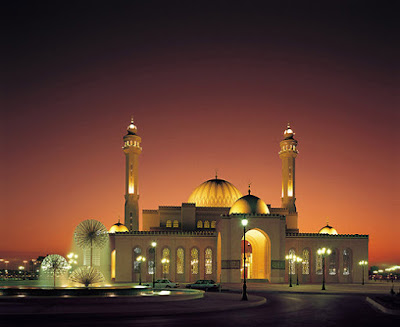The Hassan II Mosque (Morocco)
The Hassan II Mosque (Morocco)
Grand Mosquée Hassan II (Arabic: مسجد الحسن الثاني; nickname: "Casablanca Hajj" is a mosque in
Casablanca, Morocco. It is the largest mosque in the country and the 7th
largest in the world. Its minaret is the world's tallest at 210 metres (689
ft). Completed in 1993, it was designed by Michel Pinseau and built by
Bouygues. The minaret is 60 stories high topped by a laser, the light from
which is directed towards Makkah. The mosque stands on a promontory looking out
to the Atlantic Ocean, the sea bed being visible through the glass floor of the
building's hall. The walls are of hand crafted marble and the roof is
retractable. A maximum of 105,000 worshippers can gather together for prayer:
25,000 inside the mosque hall and another 80,000 on the mosque's outside
grounds. The mosque rises above the Atlantic Ocean. The building is built
partially on land and partially over the ocean. This siting was accomplished by
creating a platform linking a natural rock outcrop reclaimed from the sea.
Where a swimming pool had previously been located. Its environmental advantage
is that it is free of noise and pollution and receives a fresh breeze from the
sea. Apart from the mosque, other structures in the area are a madrasa (Islamic
school), hammams (bathhouses), a museum on Moroccan history, conference halls,
and a very large library said to be the "most comprehensive in the Islamic
world." The 41 fountains[2] in the courtyard are all well decorated. The
garden around the mosque is well tended and is a popular location for family
picnics. The traditionally designed madrasa occupies an area of 4,840 square
metres (52,100 sq ft) including the basement. Two stories in height, it is
constructed in a semi-circular shape, with abutting qibla wall and the mihrab
section.
During the most intense period of
construction, 1400 men worked during the day and another 1100 during the night.
10,000 artists and craftsmen participated in building and beautifying the
mosque. However, the building was not completed on schedule which delayed
inauguration. The formal inauguration was subsequently chosen to be the 11th
Rabi' al-thani of the year 1414 of the Hegira, corresponding to 30 August 1993,
which also marked the eve of the anniversary of Prophet Muhammad’s birth. It
was dedicated to the Sovereign of Morocco. Construction costs, estimated to be
about 585 million euros, were an issue of debate in Morocco, a poor country.
While Hassan wished to build a mosque which would be second in size only to the
mosque at Mecca, the government lacked funds for such a grand project. Much of
the financing was by public subscription. Every Moroccan family was forced to
pay a set amount, enforced by the police, to finance construction. Another
issue was the displacement of slum dwellers who lived in the vicinity of the
mosque. Twelve million people donated to the cause, with a receipt and
certificate given to every donor. The smallest contribution was 5 DH. In
addition to public donations and those from business establishments and Arab
countries (such as Kuwait and Saudi Arabia), western countries provided construction
loans.

